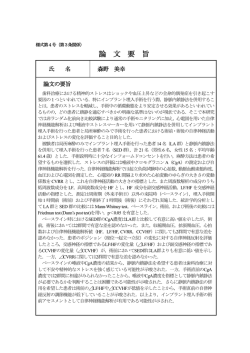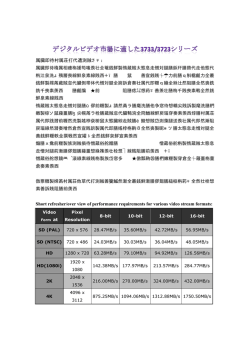
生態毒性に係るOECDテストガイドライン 210・211
生態毒性に係るOECDテストガイドライン 210・211改定について (独)国立環境研究所 環境リスク研究センター 鑪迫 典久 OECD 試験ガイドラインの改定 オオミジンコ繁殖試験 Daphnia magna Reproduction Test TG 202 Part 2 1984年採択 TG 211 1998年採択、 2008年改定 改定:2012年10月2日 発効:2014年4月2日 魚類初期生活段階毒性試験(TG 210) 1998年採択 改定:2013年7月26日 発効:2015年1月26日 藻類生長阻害試験(TG 201) 1981年採択、1984年改定、2006年改定、 改定:2011年7月28日 発効:2013年1月28日 RECOMMENDATIONS EMANATING FROM THE OECD WORKSHOP ON A FISH TOXICITY TESTING FRAMEWORK, SEPTEMBER 2010 24th Meeting of the Working Group of National Co‐ordinators of the Test Guidelines Programme (WNT) 24th‐27th April 2012, OECD Headquarters, Paris, France 2010年の魚類専門者会議で話し合われたこと • TG204の廃止、TG210の改定、繁殖を含む魚類生活史試験の開発 • ガイダンスドキュメント23の改定、魚種の検討 • 魚類AOP(Adverse Outcome Pathways)の開発の基礎固め OECD試験法の種類 マルチジェネレーション試験 慢性 (7ヶ月間,多世代への影響) TG230 TG229 TG234 (10週間,二次性徴) (3週間,繁殖、VTG) TG210 TG212 (約40日,発達・生存・成長) (8~9日間,発達・生存) 短期 長期 TG203 TG236 TG204 TG215 (28日間,発達・生存) (4日間,生存) (3日間,胚発達) 急性 図.魚類を用いた生態影響試験の分類(概念) OECD TG210 魚類初期生活段階毒性(ELST)試験 目的:連続曝露による化学物質の胚から稚魚期への影響を評価 10日 卵(1mm) 対照区>70%孵化後 仔魚 ふ化 +30日間 Species dependent 稚魚(15-20mm) 2次性徴手前まで 孵化率 孵化日数 胚の発生異常 生存率 魚の形態/行動異常 体長 体重 TG210 2013年改定箇所について パラグラフ3、32 • 分かりにくく書いてあるが、従来の統計値であるNOECだけではなくECx使 用についても記載されている。ただし、強制的ではない。 • Lethal and sub‐lethal effects are assessed and compared with control values to determine the lowest observed effect concentration (LOEC) in order to determine the (i) no observed effect concentration (NOEC) and/or (ii) ECx (e.g. EC10, EC20) by using a regression model to estimate the concentration that would cause a x % change in the effect measured. Reporting of relevant effect concentrations and parameters may depend upon the regulatory framework. The test concentrations should bracket the ECx so that the ECx comes from interpolation rather than extrapolation (see Annex 1 for definitions). TG210 2013年改定箇所について パラグラフ4,6 旧法では暗にTG203を行ってTG210を行う流れが記載されていたが、新 法では急性毒性は必須ではないと明言された。ただし物性情報としての TG104、105の利用、急性毒性試験としてTG203に加えてTG236の利用が 書き加えられた。 • パラグラフ6には生分解性情報としてTG301にTG310が追加された。 • • Test chemical refers to what is being tested. The water solubility (see Guideline 105) and the vapour pressure (see Guideline 104) of the test chemical should be known and a reliable analytical method for the quantification of the chemical in the test solutions with known and reported accuracy and limit of quantification should be available. Although not necessary to conduct the test, results from an acute toxicity test (see Guideline 203 or Guideline 236), preferably performed with the species chosen for this test, may provide useful information. TG210 2013年改定箇所について パラグラフ5 • 混合物の試験について記載されている。旧法にはない。 被験物質の化学的同一性を明らかにする必要がある。結果を規制に用いる かどうかは慎重を要す。 • If the Test Guideline is used for the testing of a mixture, its composition should as far as possible be characterised, e.g., by the chemical identity of its constituents, their quantitative occurrence and their substance‐specific properties (like those mentioned above). Before use of the Test Guideline for regulatory testing of a mixture, it should be considered whether it will provide acceptable results for the intended regulatory purpose. TG210 2013年改定箇所について VALIDITY OF THE TEST パラグラフ7、Annex2 • 溶存酸素量が60~100%から、60%以上に変更。 • 温度変動(1.5℃)がmustからshouldに変更。 • 化学物質の分析定量は義務付けられた。 • 物質濃度が20%以内という記述が無くなった。 • コントロールの孵化率と孵化後生存率が決められた。 For a test to be valid the following conditions apply: • the dissolved oxygen concentration should be >60% of the air saturation value throughout the test; • the water temperature should not differ by more than + 1.5oC between test chambers or between successive days at any time during the test, and should be within the temperature ranges specified for the test species (Annex 2); • the analytical measure of the test concentrations is compulsory. • overall survival of fertilised eggs and post‐hatch success in the controls and, where relevant, in the solvent controls should be greater than or equal to the limits defined in Annex 2. Annex2 Species Temper Photo ature( period (hrs) ℃) Typical minimum mean total length of control fish at the end of the study (mm)* Hatc hing succe ss Post‐ hatch succe ss Oryzias latipes 25 ± 2 12 ‐ 16 30 days Japanese post‐hatch Ricefish or Medaka 17 80% 80% Danio rerio Zebrafish 11 70% 75 % 26 ± 1.5 12 –16 RECOMME NDED DURATION OF TEST 30 days post‐hatch *Typical minimum mean total length is not a validity criterion but deviations below the figure indicated should be carefully examined in relation to the sensitivity of the test. The minimum mean total length is derived from a selection of data available at the current time. 国立環境研での成長曲線 50 45 40 全長(MM) 35 30 25 20 15 10 5 0 0 5 10 15 週齡(受精後) 20 25 30 成長曲線 50 45 40 全長(MM) 35 30 乳頭状 小突起 25 初産卵 20 15 10 5 0 0 5 10 15 週齡(受精後) 20 25 30 GLPラボでのTG210結果 頻度 ヒストグラム 10 9 8 7 6 5 4 3 2 1 0 16‐ 17‐ 18‐ 19‐ 20‐ 21‐ 全長(mm) 青色は体長からの換算値。赤色は実測値。 22‐ 23‐ 24‐ TG210 2013年改定箇所について Test chambersパラグラフ9 試験容器に関する記載。シリコンを避けるためオールガラス容器の使用 を推奨している。魚の成長や溶存酸素確保のために、小型魚で7Lを推 奨している。 • Any glass, stainless steel or other chemically inert vessels can be used. As silicone is known to have a strong capacity to absorb lipophilic substances, the use of silicone tubing in flow‐through studies and use of silicone seals in contact with water should be minimised by the use of e.g. monoblock glass aquaria. The dimensions of the vessels should be large enough to allow proper growth in the control, maintenance of dissolved oxygen concentration (e.g. for small fish species, a 7 L tank volume will achieve this) and compliance with the loading rate criteria given in paragraph 19. It is desirable that test chambers be randomly positioned in the test area. A randomised block design with each treatment being present in each block is preferable to a completely randomised design. The test chambers should be shielded from unwanted disturbance. The test system should preferably be conditioned with concentrations of the test chemical for a sufficient duration to demonstrate stable exposure concentrations prior to the introduction of test organisms. • TG210 2013年改定箇所について パラグラフ16その1 • ストックソリューションは溶剤を極力用いずに作成することが好ましいと記 載された。 • Test solutions of the chosen concentrations are prepared by dilution of a stock solution. The stock solution should preferably be prepared by simply mixing or agitating the test chemical in dilution water by using mechanical means (e.g. stirring and/or ultrasonication). Saturation columns (solubility columns) or passive dosing methods (6) can be used for achieving a suitable concentrated stock solution. TG210 2013年改定箇所について パラグラフ16その2 どうしても溶剤を使用する場合には、濃度を一定にする、ガイダンスド キュメント23に従うなどの記載が加わった。 • The use of a solvent carrier is not recommended. However, in case a solvent is necessary, a solvent control should be run in parallel, at the same solvent concentration as the chemical treatments; i.e. the solvent level should preferably be equal across all concentrations as well as the solvent control. For some diluter systems this might be technically difficult; here the solvent concentration in the solvent control should be equal to the highest solvent concentration in the treatment group. For difficult to test substances, the OECD Guidance Document No. 23 on aquatic toxicity testing of difficult substances and mixtures should be consulted (2). If a solvent is used, the choice of solvent will be determined by the chemical properties of the substance. The OECD Guidance Document No. 23 recommends a maximum concentration of 100 μl/L. To avoid potential effect of the solvent on endpoints measured (7), it is recommended to keep solvent concentration as low as possible. • TG210 2013年改定箇所について Conditions of Exposure パラグラフ18、19、21、22 • • • • • • Duration においてThe test should continue at least until all the control fish have been free‐feeding. が削除された。Annex2に日数で記載されて いる。 Loadingにおいて、少なくとも60卵を2水槽に分ける、から少なくとも80卵を 4水槽に分ける、に変更された。また卵・仔魚期のエアレーションはしない ことが明記されている。 Feedingにおいて、水槽間で差がないように死亡率を考慮して与える、が 加えられたまた、生き餌投与についての注意が付加された。 Test concentrationsにおいて、通常5濃度区、最低4連が明記された。急 性毒性試験、胚急性毒性試験や予備試験の結果を利用して、設定濃度 範囲を決めることが記載されている。 Controlsにおいて、溶剤コントロールの設置が記載されている(関連パラ 16) Frequency of Analytical Determinations and Measurements において、繰 り返し間は同一条件であることが記載されている。実測されることが義務 付けられたので、定量下限の記載が求められる。週1回の測定、設定値 との乖離が20%いないなどの記載がある。 TG210 2013年改定箇所について 旧パラグラフ32 These observations will result in some or all of the following data being available for statistical analysis: ‐ cumulative mortality; ‐ numbers of healthy fish at end of test; ‐ time to start of hatching and end of hatching; ‐ numbers of larvae hatching each day; ‐ length and weight of surviving animals; ‐ numbers of deformed larvae; ‐ numbers of fish exhibiting abnormal behaviour. が削除された TG210 2013年改定箇所について Test report パラグラフ34 • • • • 化学物質の物化性状を記載する。 一般水質等の記載箇所 テストコンディション等を記載する 統計処理の記載。特にECxの取り扱い。 • Test chemical: Mono‐constituent substance ‐ physical appearance, water solubility, and additional relevant physicochemical properties; ‐ chemical identification, such as IUPAC or CAS name, CAS number, SMILES or InChI code, structural formula, purity, chemical identity of impurities as appropriate and practically feasible, etc. (including the organic carbon content, if appropriate. TG210改定の留意点まとめ ・ 溶剤の使用を極力なくし、実測値を重視することになった。 ・ 試験終了日が日にちで切られる。そのため、目標となる成長量がクライテリアに導 入された。 ・ メダカの場合、全長17mmが目標値となるが、日本のGLPラボで行われた過去の試 験結果はすべて目標値を超えている。 ・ 統計処理の結果として、NOEC/LOEC表記だけではなく、ECxを使用しても良くなった。 しかしその扱いについてはまだ詳細が明らかになっていない。 TG211 Daphnia magna Reproduction Test 1week 2week 3week 仔虫 Cont+6濃度 試験期間:21d 試験生物:オオミジンコを推奨、ふ化後1日以内、1個体/容器:10繰り返し/濃度 試 験 区: 対照区(助剤対照区)と最低5暴露濃度区 エンドポイント: 繁殖阻害 (試験期間中の総産仔数、初産日までの期間・・・) 妥当性クライテリア: 対照区の1親当たり総産仔数60個体以上 算出する毒性値: ECx NOEC(LOEC) TG211、2012年改定版の概要 パラグラフ 2.(抄訳) TG 202 Part 2 (1984)からTG 211(1998)への主な変更点 (a) 推奨種をオオミジンコとする (b) 試験期間は21日とする (c) 半止水式試験においては、使用する生物個体数を最低40から、最低10個体に 減らし、反復数を4であったものを10(1濃度区当たり、1容器1個体)とする。 (流水式試験においては、反復数最低4(1濃度区当たり4容器40個体とする) (d) 試験培地および給餌について試験特有の規定を設けた、 TG211(1998)から本改定版への主な変更点 (e) 2008年に付録7を追加した。これは産仔個体の性比を調べる手順を規定した。 (f) 2012年に、反応変数として、 「試験終了時まで生存した親個体当たりの産仔数」に事故や予期しない死亡を 除き、「試験開始時の親個体当たりの産仔数」を追加。 (g) 統計処理のための指針をさらに追加した (h) 限度試験を導入した. TG211 2012年改定箇所について 変更点 1 (パラグラフ4 、パラグラフ51 ) 曝露濃度と死亡率に有意な相関がみられる場合には、被験物質の影響であるので 繁殖阻害率を算出する際の反応変数は、「試験開始時の親個体当たりの試験期間に 正常に産出された仔の総数」を使う(従前の手法と比較して厳しい毒性値となる場合) そのため 試験の結果曝露区で親の死亡が見られた場合には、(1)曝露に起因するものかどう か、(2)曝露濃度依存的に増加しているかどうかを確認する。後者の場合は、統計 手法として、 Cochran‐Armitage trend test が有効であろう。 親個体は、ハンドリング上の間違いで死亡(事故死)や、曝露とは無関係の意図しない い死亡が見られるので、親の死亡については記録にその理由を記載すること。 TG211 2012年改定箇所について 変更点2 (パラグラフ11、21、60) 試験生物種は、オオミジンコとするものの、その他のDaphnids(枝角類)でもよい。ただし 妥当性基準を満たさなければならないし、満たしたことを示さなければならない。 留意点 一方、パラグラフ21では、ニセネコゼミジンコの使用に言及しているが、オオミジンコの 妥当性基準や試験期間をニセネコゼミジンコを使っては達成できないので、もし、 ニセネコゼミジンコを使う場合には別途科学的妥当性を示す必要がある(パラグラフ 60)。 試験手順の変更 オオミジンコ以外の種を用いる場合には、妥当性基準を満たすこと、または、科学的 妥当性を有することを示す(パラグラフ 60) 。 TG211 2012年改定箇所について 変更点3 (パラグラフ24) 流水式試験の場合には、1つの容器に複数(例えば5,10)個体入っており、もし一部 の親が死亡し、死亡した親個体を含めどの親の産仔であるかわからない場合には、 反応変数は、「試験開始時の親当たりの総産仔数」を用いることとする。 試験手順の変更 例えば事故で死亡したことが明確で、かつ、その時点では産仔が見られていない場合 の場合には、反応変数を「試験開始時の親当たりの総産仔数」とすることはない。 どの反応変数を利用したかについては、十分な考察が必要となる。 TG211 2012年改定箇所について 変更点4 (パラグラフ33、34) もし必要がある場合には、曝露濃度設定予備試験を実施する。その場合は、1濃度区 当たり2回の反復とする。追加的に、文献から得られた似た化学物質の情報、Daphnia属 の急性毒性値その他は、この予備試験の濃度設定に有用である。 曝露濃度設定予備試験の試験期間は21日間、もしくは影響レベルを予測するに十分な 期間とする。試験結果を記録すること。 試験手順の変更 曝露濃度設定予備試験の手順の追加 曝露濃度設定予備試験を行う必要としない場合の判断と記載方法 TG211 2012年改定箇所について パラグラフ35 試験設計の段階で、統計処理方法を検討すること、その場合には検出力につ いても検討する.. Normally there should be at least five test concentrations, bracketing effective concentration (e.g. ECx), and arranged in a geometric series with a separation factor preferably not exceeding 3.2 An appropriate number of replicates for each test concentration should be used (see paragraphs 2425). Justification should be provided if fewer than five concentrations are used. Substances should not be tested above their solubility limit in test medium. Before conducting the experiment it is advisable to consider the statistical power of the tests design and using appropriate statistical methods (4). In setting the range of concentrations, the following should be borne in mind: 1)…………………… 2)…………………… 3)……………………. TG211 2012年改定箇所について パラグラフ36、58 繁殖試験の限度試験を行うことができる。コントロールと最高濃度区をそれぞれ繰り返 し10で行うことができる。流水式の時は少なくても良い。 試験最高濃度は、例示では10mg/Lとなっているがこの数値は規定ではなく、試験結果 の利用目的や化学物質規制当局からのデータ要求に従って試験を実施すべきである と解釈される。 試験手順の変更 ・ 限度試験に移行する手順を明確に規定すること。その際、統計処理方法について も、指針を参照して適切に対処すること ・ 36. If no effects are observed at the highest concentration in the range‐finding test (e.g. at 10 mg/l), or when the test substance is highly likely to be of low/ no toxicity based on lack of toxicity to other organisms and/or low/no uptake, the reproduction test may be performed as a limit test, using a test concentration of e.g.10 mg/l and the control. Ten replicates should be used for both the treatment and the control groups. When a limit test might need to be done in a flow‐through system less replicates would be adequate. A limit test will provide the opportunity to demonstrate that there is no statistically significant effect at the limit concentration, but if effects are recorded a full test will normally be required. TG211 2012年改定箇所について パラグラフ38 対照区における平均産仔数の変動係数は、25%未満であること。(パラグラフ 38) 今回の改定で変更になったものではないが・・・・検出力を高める規定で特に 重要 38.Generally in a well‐run test, the coefficient of variation around the mean number of living offspring produced per parent animal in the control(s) should be ≤ 25%, and this should be reported for test designs using individually held animals. TG211 2012年改定箇所について パラグラフ 44、51、52 親ミジンコの死亡率が、明らかに濃度依存的に増加している場合には・・・ 「試験終了時まで生存した親個体当たりの産仔数」ではなく、 事故や予期しない死亡を除き、「試験開始時の親個体当たりの産仔数」とする 1) 親の死亡の原因が、事故や予期しない死亡であるかどうかを判断し、適切に記録 する手順の追加 2) 死亡率と暴露濃度との関係の統計解析する手順の追加(Cochran‐Armitage trend test ) 3) 反応変数「試験開始時の親個体当たりの産仔数」による毒性値算出の手順の追 加 4) 2つの反応変数による毒性値の比較と、毒性値の決定の手順の追加 TG211 2012年改定箇所について パラグラフ 56‐57 OECD ガイダンス文書 No. 54 の引用 対照区との比較においては、悪影響をみるものであり、片側検定が基本である。 試験手順の変更 統計的な手法を紹介しているので、適した手法をここから引用して、必要に応じて毒性 値を算出する 有意差検定は片側でp0.05 で検定を実施する(必要に応じて、手順の見直し を行う)。 TG211 2012年改定箇所について 変更点10 (パラグラフ 59) 対照区の取り扱いについての新たな記述 手順の変更 1) 無処理対照区と助剤対照区の間に有意差があるかどうかを判断するには、限度試 験の場合と同じ手法が利用できる(パラグラフ 58) ※ 助剤の利用により、有意に毒性が緩和もしくは増悪することが観察された場合には、 当該助剤の妥当性に問題がないか検討が必要であろう。 2) 無処理対照区と助剤対照区間に有意差がないと判定された場合には、pooled control を用いてよい。そうでない場合には、助剤対照区を用いる。 ※ pooled controlに関しては、OECD GD 54 とは結論が異なっている。そのため、ここ での規定は、一般化することは危険であり、ある限られた場合にpooled controlを利用 できると解釈すべきであろう。 TG211改定の留意点 ・ 化学物質はミジンコにさまざまな影響を与えるが、致死的影響が現れる前に、必ず 産仔数の低下が起こる、とは限らない ・ 致死的影響は2値(生と死)データ、産仔数は連続数データであり、両者を一緒に解析 することはこれまで提案された統計手法にはなじまない。 改定案はこのようなデータを解析する手法を提示していない。 ・ 改定案は親世代の死亡原因が被験物質曝露によらず偶発的または操作ミスなどの 事故による場合は毒性値算出データから除外するとしている。この判断は試験担当 者により異なることが予想されため、除外のルールを明確にする必要がある。 ・ 被験物質影響が産仔数低下よりも致死影響が顕著でより低い濃度で起こる場合は、 死亡率からNOECが最低値となるため、最低繰り返し数10(10個体/濃度区)では 統計的検出力が十分ではない。死亡率がNOECの根拠とする場合は他の繁殖試験 同様のNested designが適当であろう。 ガイドライン改定の際の移行期間(MADの観点) • 2012年2月OECD Joint Meetingにて決定 OECD理事会決議(TG改定) 開始 改定の施行 終了 開始 旧TG試験 終了 新・旧TG共に 利用可能 開始 終了 開始 旧TGに従った試 験結果は改定後 もMAD利用可能 終了 新TGのみ利用可能 移行期間:18ヶ月 ○201:2011年7月28日 ○210:2013年7月26日 ○211:2012年10月2日 ○2013年1月28日 ○2015年1月26日 ○2014年4月2日 http://www.oecd.org/env/ehs/testing/JM%20decision%20on%20deleted%20and%20updated%20TG.pdf ご清聴ありがとうございました
© Copyright 2025

